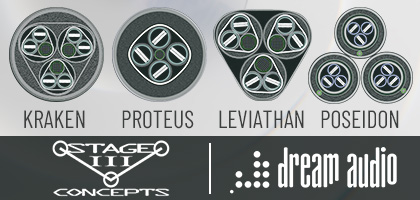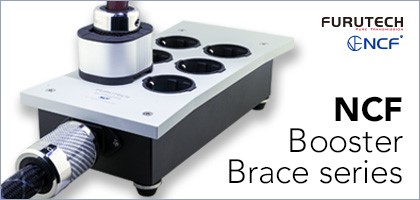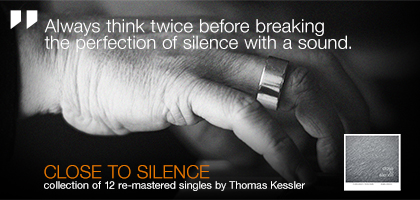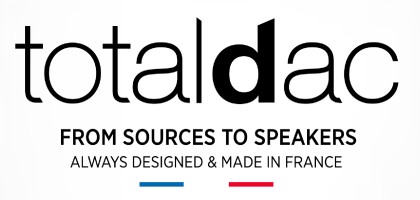No. 257 October 2025
- COVER REVIEW: ANCIENT AUDIO Silver Grand Mono Mk II ⸜ power amplifier • monoblocks » POLAND • Kraków
- KRAKOW SONIC SOCIETY № 153: 30 years of ANCIENT AUDIO » POLAND • Kraków
- FEATURE ⸜ music & technology: HISAO NATSUME presents - In search for the lost great pianism Chopin tradition » part 2 (France) » JAPAN • Tokyo
- REVIEW: AUDIOPHONIQUE Classic AP 300D ⸜ power amplifier » POLAND • Pruszków
- REVIEW: AVATAR AUDIO Holophony No. 1 ⸜ loudspeakers • floor-standing » POLAND • Osowicze
- REVIEW: DIVALDI Gold PA One ⸜ integrated amplifier » POLAND • Kraków
- REVIEW: J.SIKORA Aspire ⸜ turntable (deck + tonearm) » POLAND • Lublin
- REVIEW: MB AUDIO CABLE Silver ⸜ analog interconnect ⸜ RCA » POLAND • Turza Śląska
- REVIEW: XACT N1 ⸜ LAN switch » POLAND • Wrocław
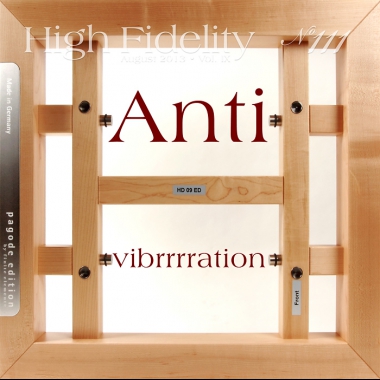
|
AUDIO ACCESSORIES 
The cover of this “High Fidelity” issue leaves no doubt about its main subject: anti-vibration platforms. They are a specific component of an audio system (you will find definitions of these and many other terms in the previous installments of the I’m an Audiophile and I’m proud of it series; see their listing below). While often equal in terms of costs to the main audio components, they are usually regarded as something additional and thus not very important. It is evident even in the name given to the whole group of these products: the accessories. Coming from the Latin accessorius meaning ‘additional irrelevant’, it is defined by the Oxford English Dictionary as “something contributing in a subordinate degree to a general result or effect; minor fittings or attachments for a motor-car, etc.” This is a modern definition that minimizes the value of accessories, relegating them to a group of things "possible, though not necessary." In a similar vein, the Merriam-Webster Online Dictionary states that it’s “an object or device not essential in itself but adding to the beauty, convenience, or effectiveness of something else”. The insignificance of accessories is emphasized again, although the idea of them “contributing” or “adding” something to a general result implies a stronger relationship than one might think at first glance. 
In audio, the understanding of the meaning of accessories has gone exactly the opposite way. From an utter indifference to full recognition and including them in the main group of “audio products”, on equal footing with the three aforementioned basic components. At least that’s my understanding and that of the people who have some knowledge about audio. Let’s list the products that are defined as ‘accessories’. There’s lots of them but the most important are:
Looking at the above list it is easy to notice the contradiction, corresponding to its etymology, between the understanding of this category by modern linguists, the understanding of their role by the people associated with the audio, and the reality. Let’s start from the beginning, which in our case means cables and power cords. It is obvious that any audio system will not work without them. To operate, electronic devices need to be fed by electric power and be somehow coupled with each other. Even if we assume that wireless signal transmission is just around the corner, we are still forced to use classic power cords to provide electric power. However, as I understand it, for all these years since the concept of hi-fi was born, in other words since the end of World War II when many skilled engineers returned to their homes bringing with them lots of army surplus electronics, no one worried too much about how the components were coupled or how they were powered. Lamp cord would do perfectly. Please have a look at the pictures of Quad or McIntosh devices included, respectively, in Ken Kessler’s books Quad: The Closest Approach (International Audio Group Ltd, 2003), and McIntosh "…for the love of music…" (McIntosh Laboratory, Inc., 2006). The cables that they present don’t even deserve a spit. One has a similar impression of indifference to their quality while reading the history of "Hi-Fi News" magazine and hence the story of the audio industry in the UK and the US written by Ken Kessler and Steve Harris and titled Sound Bites. 50 Years of Hi-Fi News (IPC Media, 2005). Even more recently, in the 1990s and 2000s, the magazines being members of EISA (European Imaging and Sound Association) granting awards by the same name never even hinted at a separate category called "cables" (cf. George Cole, 25 Years of Excellence. EISA, EISA, 2007). And we would expect that the chief editors of perhaps not the most important but certainly influential EISA audio magazines, most of them with an engineering background, should know that the cables are not just "necessary" for any audio system to work, but are equally important as other components and can often be a deciding factor for the system sound. Hence, they can cost as much as other audio components. It seems, however, that the engineers find it very hard to take to something that goes beyond their academic background, which is flawed (incomplete) in the sense of its very casual treatment of the subject of audio signals transmission. Things seem to slowly change, though, and in the last issue of "Hi-Fi News & Record Review" its chief editor, Paul Miller, himself a great measurements specialist and, incidentally, the current chairman of EISA, conducts a group test and measures “audio-specific USB cables” (yes!). His article titled All Aboard the USB says in the introductory note that “having organised listening tests on many hundreds of cables in the past, even Paul Miller was surprised at the differences”. As if we didn’t know it and weren’t writing about it for years (see for example HERE). And for which we actually took some heat from "hardline" engineers. Now one of the biggest skeptics, a man whose jitter meters in audio devices are one of the basic measurement tools used by most companies, states that differences do exist. And he says so about USB cables, viewed by computer geeks with an aptly named zero-one attitude (cf. Paul Miller, All Aboard the USB, "Hi-Fi News & Record Review," July 2013, p. 98). The world is coming to an end! 
This way cables, slowly but steadily, leave the "gray" zone of misunderstandings and half-smiles and enter the zone of rightful audio products. Things are slightly different with anti-vibration accessories that are not “required” for the audio system to operate. While one cannot do without cables, the components, speakers and cables make a working audio system without a single anti-vibration accessory. 
The problem then was (and is) not the fact that in some cases we need to fight with vibration, but rather a proper assessment of the extent to which it affects the sound. Even though capacitors modulate the audio signal when exposed to vibration and vibrating transformers generate noise current (which is produced in a conductor when it moves through a magnetic field), their effect on the audio signal has been largely underestimated by a number of engineers. Wrongly. After years spent with all kinds of audio equipment and after hundreds of stand-alone or group tests of various products designed to reduce vibration, I have learned that the mechanical design of an audio product and the quality of the surface on which it is placed is of comparable importance to upgrading the product to a better one. It may seem exaggerated and impossible to be but I just say what I hear and what I'm convinced of. “I’m an Audiophile and proud of it” series 
IN AUDIO MAGAZINES “High Fidelity” in “Positive-Feedback Online” 
The cooperation between the American magazine “EnjoyTheMusic.com” with printed (that’s right!) journals like: “Hi-Fi+” (UK/USA), “Hi-Fi World” (UK), and “The Absolute Sound” (USA) among others, can be dated even further back. Since January this year, it also cooperates with “High Fidelity”. Recently this tendency became even stronger, because in a very short time the American magazine "TONEAudio”, which I admire for its format, invited the Serbian magazine “Mono&Stereo”, to cooperate with them – which is when they changed their logo, becoming more like their patron. At the same time an alliance between the American “Positive-Feedback Online” and the German “HiFiStatement.net” was formed. 
“High Fidelity” in “StatementHiFi.net” “High Fidelity” in “Stereo Sound” (sort of) 
|
IN THE MUSICAL WORLD  Klaus Schulze 
As you might’ve read in other reviews of this album, it’s a personal summary of this musician and composer’s creative years, a closure of his cooperation with singing women. You’ll find Lisa Gerrard, Chrysta Bell and Julia Messenger on the album. It’s a delicate, slow, and incredibly spacious record. Unfortunately, it’s boring. If Schulze represented one of the most interesting currents of electronic music to you, you’ll be disappointed – there is no experimentation, nor even an attempt at bringing in some modifications. That’s why if you’re over-encumbered with the legacy of krautrock, you shouldn’t try this album out. What you can do, however, is accept the fact that this man is no longer the young musician buying his first moog synthesizer. That’s when we can get immersed in this ambient music. The sound is pleasant, soft, spacious, although it lacks particular definition or drawing the bodies. It has a good midrange. And one more thing – the album is available in two editions: basic and limited, with the latter containing an extra disc with slightly different music. I’ve reviewed the first one, though. Sound quality  Alinson Moyet 
This is one of the most pleasant surprises of the first half of 2013. Listening to Alison Moyet’s previous release, The Turn from 2007, I was pretty disappointed – both by the contents and the sound. The eighth album in her solo career, The Minutes contains much more interesting music, based heavily on electronic sounds that bring back memories (although she does not copy her old ideas) from the time when she collaborated with Vincent Clark as the duo Yazoo. The material is diverse; Wikipedia says it’s a combination of synthpop with a touch of R&B and some pop-rock and house. Although it sounds dumb on paper, it works well in reality – it’s an album you’ll find yourself coming back to, at least for the sake of the opening track Horizon Flame or Changeling, which demonstrate the power and beauty of Moyet’s vocals; or Apple Kisses that bring back her more melancholic side. Oh, and the fantastic Right As Rain. This way I’ve mentioned four out of the first five tracks on the album, and I can assure you that it doesn’t get worse throughout the rest of it. Additionally, everything is really well engineered and produced, without a ‘plastic’ feel, with a strong groove on the bass. It will appeal to music lovers, music lovers cum audiophiles, and audiophiles alike. Please look around on the Internet – the album was also available in a limited edition with the artist’s autograph (I assume it’s legitimate :). Sound quality  Depeche Mode 
The dust hasn’t settled after May’s review of Delta Machine (many fansites have written about it – check out Delta Machine rozłożony na łopatki at “101DM.pl”) in “High Fidelity”, and I’m already holding the next single off the album, Soothe My Soul. It’s one of my favourite compositions from Delta…, so its release in three versions – two CD singles and one (12”) vinyl, was received with a smile on my face. As before, the vinyl has a much better sound – less compressed, with a better tonal balance and breath. But even the CD is nice to listen to. Sound quality  OMD 
One of the first things written in Kraftwerk’s biography Kraftwek Publikation by David Buckley (Poznań 2013) is that Andy McCluskey, the founder of Orchestral Manoeuvres in the Dark, admired the band and according to him Wolfgang Flür had the potential to become the “Tom Jones of electropop” (p. 26). The fascination with krautrock, and the whole German electronic music scene can be heard on OMD’s first albums, especially Orchestral Manoeuvres in the Dark and Organisation from 1980, and Architecture & Morality released a year later. The experimentation, as well as the shapely melodies which made the band become part of the New Romantic scene, are the key to their popularity. It all went downhill later, and the band tripped over their own feet. The latest issue of “Teraz Rock” magazine states that aside from their first two albums, the 2010 release of History Of Modern is equally important – but only the first three albums matter to me (Michał Kirmuć, OMD. Intuicja i doświadczenie, “Teraz Rock”, July 2013, page 39). Sound quality  Daft Punk 
The Tron: Legacy movie from 2010 (directed by Joseph Kosinski) was kickass on two levels – visually, and as a pretext for Daft Punk making the movie’s soundtrack. Although their previous work already had its passionate fans, only then did they appear on my musical radar. The quality of a soundtrack isn’t based on how well it works with the film, but how it fares on its own. And this movie’s soundtrack was fantastic as an independent creation. The change of direction in which the duet was headed wasn’t clear, but it was definitely a good one. Sound quality  The Postal Service 
The Internet is a tool. It is neither good nor bad, and its ethical qualification only concerns the people that use it. You can’t call it “good” or “evil”. You can, however, say how much it has changed the world. It has opened the way for obscure, unknown and forgotten bands to win the hearts of people all over the world. They can now directly communicate with their audience. The explosion of music-dedicated websites is something unique, which has long-lasting effects. We can now choose, browse and formulate our opinion based on several different sources. Rejecting the trash, i.e. the “white information noise”, has become the only problem. That’s why if you find something solid, interesting and good on the web, you have to talk about it. For me, finding the magazine “PopMatters” was a discovery like that. Long, gripping articles and lots of music I’d never heard before. The possibility of embedding a YouTube link at the end of a music review allows you to immediately get familiar with it. That’s how I’ve come across several new CDs (in under 2 months’ time!), and one of the best was Give Up, in a 10 year “anniversary” edition. The finish quality is fantastic – this is how all physically released CDs should look like! It comprises two discs – one with re-mastered material of the basic edition, and the other with additional tracks, remixes and fragments of live performances in a wonderful, thick cardboard box ornamented with drawings. Sound quality AUDIO IN MOVIES 
We talk about audio in movies whenever something interesting comes up. This time I’ll keep it short – there were turntables in two recent blockbuster sci-fi movies. In Joseph Kosinski’s (the director of Tron: Legacy) film Oblivion (2013), Tom Cruise, living on a destroyed Earth, builds himself a micro-paradise, his own world, an escapist point on his private world map. You’ll find everything that brings back positive memories from his past. That includes a turntable, part of an integrated system from the 1970s (as far as my eye could tell). Of course he’s also got a lot of LPs, mostly hard rock like Led Zeppelin and Deep Purple. What’s interesting is that the movie’s soundtrack is available as an LP. The second movie uses a turntable to highlight the main character’s defiant, perseverant, independent and unique nature – James T. Kirk, played by Chris Pine, in Star Trek: Into Darkness (dir. J.J. Abrams, 2013). As I’ve said elsewhere, turntables and audio devices are often used to signal the emotional states of movie characters, and are intended as a key to their psyche. The audio portrayed in the first movie is nothing but retro and nostalgia, whereas the second movie uses it as something to add color and depth to a character. And that’s what we should stick to. 
FOR SALE To all those who would like to buy some audio gear from a trusted source without spending a fortune, I have some equipment to offer – either from my own system or after my reviews. 1. Wireworld Platinum Eclipse RCA-RCA analog interconnect, 2 m. Reference cable for American Wireworld, of a rare two meters length. Its list price is prohibitive, but from me it’s at your arm’s reach. Useful wherever a greater distance from the source to the amplifier prevented you from purchasing a reference cable. Now it is possible. List price – 22,390 PLN, offers welcome. Condition - very good. Complete with a metal case and certificate of authenticity signed by David Saltz, the owner of Wireworld. 2. SAEC OPC-X1 optical digital cable, reviewed HERE. It’s a reference optical cable, one of the best I know. Practically unavailable outside Japan. Asking price – 1,000 PLN / 1 m, list price – 650 EUR. Virtually new, used once, for a review. 3. SAEC XR-4000 analog interconnect (balanced), reviewed HERE. Asking price – 2,000 PLN, list price – 980 EUR. Virtually new, used once, for a review. 4. Arcam Solo Movie 5.1 DVD/SACD/HDCD/CD player, multi-channel amplifier. A long name, but it’s a purist unit. Combination in a single housing an audiophile audio and video player, and a 5-channel amplifier - all in the Arcam quality. Original price - well over 10,000 PLN, asking for any offers. I used the player for a year; the amplifier section has never been used. Mechanics has been replaced for new. It sits in a box, which is a shame; should better bring some joy to someone. Reviewed HERE. 5. KingRex UC192 USB DAC – make me an offer. Reviewed by Srajan Ebaen in “6moons.com” HERE.
|
About Us |
We cooperate |
Patrons |
|
Our reviewers regularly contribute to “Enjoy the Music.com”, “Positive-Feedback.com”, “HiFiStatement.net” and “Hi-Fi Choice & Home Cinema. Edycja Polska” . "High Fidelity" is a monthly magazine dedicated to high quality sound. It has been published since May 1st, 2004. Up until October 2008, the magazine was called "High Fidelity OnLine", but since November 2008 it has been registered under the new title. "High Fidelity" is an online magazine, i.e. it is only published on the web. For the last few years it has been published both in Polish and in English. Thanks to our English section, the magazine has now a worldwide reach - statistics show that we have readers from almost every country in the world. Once a year, we prepare a printed edition of one of reviews published online. This unique, limited collector's edition is given to the visitors of the Audio Show in Warsaw, Poland, held in November of each year. For years, "High Fidelity" has been cooperating with other audio magazines, including “Enjoy the Music.com” and “Positive-Feedback.com” in the U.S. and “HiFiStatement.net” in Germany. Our reviews have also been published by “6moons.com”. You can contact any of our contributors by clicking his email address on our CONTACT page. |
 



|
   |
main page | archive | contact | kts
© 2009 HighFidelity, design by PikselStudio,
projektowanie stron www: Indecity






